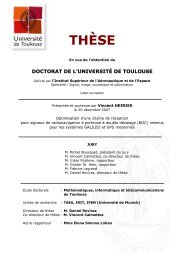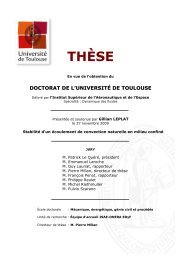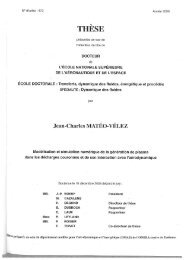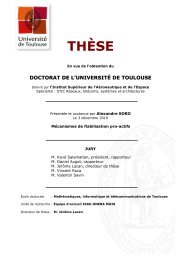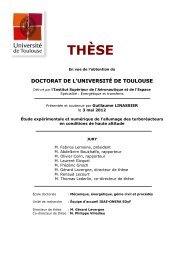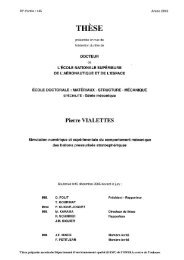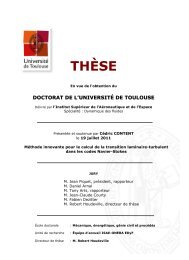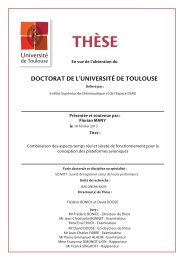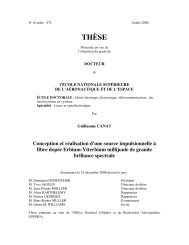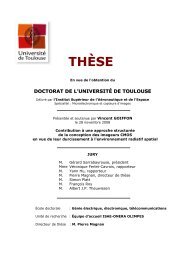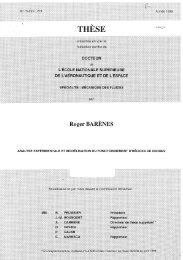292 BIBLIOGRAPHIE[44] Dai<strong>le</strong>y, R. L. Lecture notes for the workshop on H ∞ and µ methods for robust control, May21-22 1990.[45] Delpech, M., and Fourcade, J. Design of the GNC system for a new concept of X-raydistributed te<strong>le</strong>scope. In 2nd International Symposium on Formation Flying Missions and Technologies(Washington, D.C., September 14-16 2004).[46] Döll, C. La robustesse de lois de commande <strong>pour</strong> des structures f<strong>le</strong>xib<strong>le</strong>s <strong>en</strong> aéronautique etespace. PhD thesis, Éco<strong>le</strong> Nationa<strong>le</strong> Supérieure de l’Aéronautique et de l’Espace, Toulouse,France, July 2001.[47] Döll, C., and Knauf, A. Comparison in terms of size of several LFT models for the lateralmotion of a g<strong>en</strong>eric fighter aircraft. In AIAA Guidance, Navigation, and Control Confer<strong>en</strong>ceand Exhibit (San Francisco, CA, August 15-18 2005).[48] Doy<strong>le</strong>, J. C., Glover, K., Khargonekar, P. P., and Francis, B. A. State-space solutionsto standard H 2 and H ∞ control prob<strong>le</strong>ms. IEEE Transactions on Automatic Control 34, 8(August 1989), 831–847.[49] D’Souza, C. N. An optimal guidance law for formation flying and stationkeeping. In AIAAGuidance, Navigation, and Control Confer<strong>en</strong>ce and Exhibit (Monterey, CA, August 5-8 2002).[50] Dubovitsky, S., Lay, O. P., Abramovici, A., Haw<strong>le</strong>y, J. G., Kuhnert, A. C., Mulder,J. L., and Asbury, C. G. The StarLight metrology subsystem. In 2002 IEEE AerospaceConfer<strong>en</strong>ce (Big Sky, MT, March 2002), pp. 1721–1736.[51] EADS Astrium. Étude du GNC <strong>pour</strong> une mission d’astronomie/interférométrie (vo<strong>le</strong>tsystème). EAA.PS.96772.ASTR, May 2005.[52] Eberly, D. Intersection of ellipsoids. http://www.geometrictools.com/Docum<strong>en</strong>tation/IntersectionOfEllipsoids.pdf, October 11 2000. [En ligne ; Page disponib<strong>le</strong> <strong>le</strong> 29-juin-2006].[53] Erwin, R. S., Sparks, A. G., and Bernstein, D. S. Fixed-structure robust control<strong>le</strong>r synthesisvia dec<strong>en</strong>tralized static output feedback. International Journal of Robust and NonlinearControl 8 (1998), 499–522.[54] Ferguson, P., and How, J. Dec<strong>en</strong>tralized estimation algorithms for formation flying spacecraft.In AIAA Guidance, Navigation, and Control Confer<strong>en</strong>ce and Exhibit (Austin, TX, August11-14 2003).[55] Ferreres, G. A Practical Approach to Robustness Analysis with Aeronautical Applications.Springer, 1999.[56] Gahinet, P., Nemirovski, A., Laub, A. J., and Chilali, M. LMI Control Toolbox - foruse with MATLAB. User’s guide Version 1, May 1995.[57] Gaulocher, S., Chréti<strong>en</strong>, J.-P., and Pittet, C. Six-axis control design and control<strong>le</strong>r switchingfor spacecraft formation flying. In AIAA Guidance, Navigation, and Control Confer<strong>en</strong>ceand Exhibit (Keystone, CO, August 2006).[58] Gaulocher, S., Chréti<strong>en</strong>, J.-P., Pittet, C., and Alazard, D. Six-axis dec<strong>en</strong>tralizedcontrol design for spacecraft formation flying. In IEEE International Confer<strong>en</strong>ce on ControlApplications (Munich, Germany, October 4-6 2006).<strong>Commande</strong> <strong>bouc<strong>le</strong></strong> <strong>fermée</strong> <strong>multivariab<strong>le</strong></strong> <strong>pour</strong> <strong>le</strong> <strong>vol</strong> <strong>en</strong> formation de vaisseaux spatiaux
BIBLIOGRAPHIE 293[59] Geromel, J. C., Bernussou, J., and de Oliveira, M. C. H 2 -norm optimization withconstrained dynamic output feedback control<strong>le</strong>rs : Dec<strong>en</strong>tralized and reliab<strong>le</strong> control. IEEETransactions on Automatic Control 44, 7 (July 1999), 1449–1454.[60] Gill, E., and Runge, H. Tight formation flying for an along-track SAR interferometer. In54th International Astronautical Congress (IAF) (Brem<strong>en</strong>, Germany, September 29-October 32003).[61] Gim, D.-W., and Alfri<strong>en</strong>d, K. T. The state transition matrix of relative motion for theperturbed non-circular refer<strong>en</strong>ce orbit. In AAS/AIAA Space Flight Mechanics Meeting (SantaBarbara, CA, February 11-15 2001).[62] Gökcek, C. Stability analysis of periodically switched linear systems using Floquet theory.Mathematical Prob<strong>le</strong>ms in Engineering 2004, 1 (2004), 1–10.[63] Guibout, V. M., and Scheeres, D. J. Spacecraft formation dynamics and design. Journalof Guidance, Control, and Dynamics 1, 1 (January-February 2006), 121–133.[64] Gurfil, P., Idan, M., and Kasdin, N. J. Adaptive neural control of deep-space formationflying. Journal of Guidance, Control, and Dynamics 26, 3 (May-June 2003), 491–501.[65] Gurfil, P., and Kasdin, N. J. Dynamics and control of spacecraft formation flying inthree-body trajectories. In AIAA Guidance, Navigation, and Control Confer<strong>en</strong>ce and Exhibit(Montreal, Canada, August 6-9 2001).[66] Hablani, H. B., Tapper, M., and Dana-Bashian, D. Guidance algorithms for autonomousr<strong>en</strong>dezvous of spacecraft with a target vehic<strong>le</strong> in circular orbit. In AIAA Guidance, Navigation,and Control Confer<strong>en</strong>ce and Exhibit (Montreal, Canada, August 6-9 2001).[67] Hadaegh, F. Y., Ghavimi, A. R., Singh, G., and Quadrelli, M. A c<strong>en</strong>tralized optimalcontrol<strong>le</strong>r for formation flying spacecraft. In International Confer<strong>en</strong>ce on Intellig<strong>en</strong>t Technologies(Bangkok, Thailand, September 2000).[68] Hashimoto, T., Sakai, S., Ninomiya, K., Maeda, K., and Saito, T. Formation flightcontrol using superconducting magnets. In International Symposium Formation Flying Missionsand Technologies (Toulouse, France, October 29-31 2002).[69] Hill, G. W. Researches in the lunar theory. American Journal of Mathematics 1, 1 (1878),5–26.[70] Hill, G. W. Researches in the lunar theory. American Journal of Mathematics 1, 2 (1878),129–147.[71] Hill, G. W. Researches in the lunar theory. American Journal of Mathematics 3, 3 (1878),245–260.[72] Höllig, K. Grundlag<strong>en</strong> der Numerik. MathText, Zavelstein, Germany, 1998.[73] How, J. P., and Til<strong>le</strong>rson, M. Analysis of the impact of s<strong>en</strong>sor noise on formation flyingcontrol. In 2001 American Control Confer<strong>en</strong>ce (Arlington, VA, June 25-27 2001), pp. 3986–3991.[74] Hughes, P. C. Spacecraft Attitude Dynamics. John Wi<strong>le</strong>y & Sons, 1986.<strong>Commande</strong> <strong>bouc<strong>le</strong></strong> <strong>fermée</strong> <strong>multivariab<strong>le</strong></strong> <strong>pour</strong> <strong>le</strong> <strong>vol</strong> <strong>en</strong> formation de vaisseaux spatiaux
- Page 1:
THÈSEEn vue de l'obtention duDOCTO
- Page 5:
iRemerciementsÀ l’issue de la lo
- Page 10 and 11:
viTABLE DES MATIÈRESII Modèles po
- Page 12 and 13:
viiiTABLE DES MATIÈRES4.5.4 Probl
- Page 14 and 15:
xTABLE DES MATIÈRESE Non-existence
- Page 16 and 17:
xiiSIGLES ET ACRONYMESSigleExplicat
- Page 18 and 19:
xivTABLE DES FIGURES3.2 Orbite halo
- Page 20 and 21:
xviTABLE DES FIGURES5.9 Effet d’u
- Page 23 and 24:
Liste des tableaux1.1 Missions de v
- Page 25 and 26:
Liste des publications[1] Gaulocher
- Page 27:
Première partieIntroduction1
- Page 30 and 31:
4 1. LE VOL EN FORMATIONLe vol en f
- Page 32 and 33:
6 1. LE VOL EN FORMATIONLa Fig. 1.3
- Page 34 and 35:
8 1. LE VOL EN FORMATIONSoleil. Le
- Page 36 and 37:
10 1. LE VOL EN FORMATIONFigure 1.6
- Page 38 and 39:
12 1. LE VOL EN FORMATIONÀ l’int
- Page 40 and 41:
14 1. LE VOL EN FORMATIONque d’ha
- Page 42 and 43:
16 1. LE VOL EN FORMATIONLa Fig. 1.
- Page 45:
Deuxième partieModèles pour le vo
- Page 48 and 49:
22 2. DYNAMIQUE TRANSLATIONNELLE EN
- Page 50 and 51:
24 2. DYNAMIQUE TRANSLATIONNELLE EN
- Page 52 and 53:
26 2. DYNAMIQUE TRANSLATIONNELLE EN
- Page 54 and 55:
28 2. DYNAMIQUE TRANSLATIONNELLE EN
- Page 56 and 57:
30 2. DYNAMIQUE TRANSLATIONNELLE EN
- Page 58 and 59:
32 2. DYNAMIQUE TRANSLATIONNELLE EN
- Page 60 and 61:
34 2. DYNAMIQUE TRANSLATIONNELLE EN
- Page 62 and 63:
36 2. DYNAMIQUE TRANSLATIONNELLE EN
- Page 64 and 65:
38 2. DYNAMIQUE TRANSLATIONNELLE EN
- Page 66 and 67:
40 2. DYNAMIQUE TRANSLATIONNELLE EN
- Page 68 and 69:
42 2. DYNAMIQUE TRANSLATIONNELLE EN
- Page 70 and 71:
44 2. DYNAMIQUE TRANSLATIONNELLE EN
- Page 72 and 73:
46 2. DYNAMIQUE TRANSLATIONNELLE EN
- Page 74 and 75:
48 2. DYNAMIQUE TRANSLATIONNELLE EN
- Page 76 and 77:
50 2. DYNAMIQUE TRANSLATIONNELLE EN
- Page 78 and 79:
52 2. DYNAMIQUE TRANSLATIONNELLE EN
- Page 80 and 81:
54 2. DYNAMIQUE TRANSLATIONNELLE EN
- Page 82 and 83:
56 2. DYNAMIQUE TRANSLATIONNELLE EN
- Page 84 and 85:
58 2. DYNAMIQUE TRANSLATIONNELLE EN
- Page 86 and 87:
60 3. MODÈLE COUPLÉ EN TRANSLATIO
- Page 88 and 89:
62 3. MODÈLE COUPLÉ EN TRANSLATIO
- Page 90 and 91:
64 3. MODÈLE COUPLÉ EN TRANSLATIO
- Page 92 and 93:
66 3. MODÈLE COUPLÉ EN TRANSLATIO
- Page 94 and 95:
68 3. MODÈLE COUPLÉ EN TRANSLATIO
- Page 96 and 97:
70 3. MODÈLE COUPLÉ EN TRANSLATIO
- Page 98 and 99:
72 3. MODÈLE COUPLÉ EN TRANSLATIO
- Page 100 and 101:
74 3. MODÈLE COUPLÉ EN TRANSLATIO
- Page 102 and 103:
76 3. MODÈLE COUPLÉ EN TRANSLATIO
- Page 104 and 105:
78 3. MODÈLE COUPLÉ EN TRANSLATIO
- Page 106 and 107:
80 3. MODÈLE COUPLÉ EN TRANSLATIO
- Page 108 and 109:
82 3. MODÈLE COUPLÉ EN TRANSLATIO
- Page 110 and 111:
84 3. MODÈLE COUPLÉ EN TRANSLATIO
- Page 112 and 113:
86 3. MODÈLE COUPLÉ EN TRANSLATIO
- Page 114 and 115:
88 3. MODÈLE COUPLÉ EN TRANSLATIO
- Page 116 and 117:
90 3. MODÈLE COUPLÉ EN TRANSLATIO
- Page 118 and 119:
92 3. MODÈLE COUPLÉ EN TRANSLATIO
- Page 120 and 121:
94 3. MODÈLE COUPLÉ EN TRANSLATIO
- Page 122 and 123:
96 3. MODÈLE COUPLÉ EN TRANSLATIO
- Page 124 and 125:
98 3. MODÈLE COUPLÉ EN TRANSLATIO
- Page 126 and 127:
100 3. MODÈLE COUPLÉ EN TRANSLATI
- Page 128 and 129:
102 3. MODÈLE COUPLÉ EN TRANSLATI
- Page 130 and 131:
104 3. MODÈLE COUPLÉ EN TRANSLATI
- Page 132 and 133:
106 3. MODÈLE COUPLÉ EN TRANSLATI
- Page 134 and 135:
108 3. MODÈLE COUPLÉ EN TRANSLATI
- Page 136 and 137:
110 3. MODÈLE COUPLÉ EN TRANSLATI
- Page 138 and 139:
112 3. MODÈLE COUPLÉ EN TRANSLATI
- Page 140 and 141:
114 3. MODÈLE COUPLÉ EN TRANSLATI
- Page 142 and 143:
116 3. MODÈLE COUPLÉ EN TRANSLATI
- Page 144 and 145:
118 3. MODÈLE COUPLÉ EN TRANSLATI
- Page 146 and 147:
120 3. MODÈLE COUPLÉ EN TRANSLATI
- Page 148 and 149:
122 3. MODÈLE COUPLÉ EN TRANSLATI
- Page 150 and 151:
124 3. MODÈLE COUPLÉ EN TRANSLATI
- Page 153 and 154:
Chapitre 4Méthodologie pour le pil
- Page 155 and 156:
4.1 Revue bibliographique 129Hussei
- Page 157 and 158:
4.2 Objectifs 131du système en bou
- Page 159 and 160:
4.3 Analyse de la dynamique 133d’
- Page 161 and 162:
4.3 Analyse de la dynamique 1352402
- Page 163 and 164:
4.4 Modèle linéaire fractionnaire
- Page 165 and 166:
4.4 Modèle linéaire fractionnaire
- Page 167 and 168:
4.4 Modèle linéaire fractionnaire
- Page 169 and 170:
4.4 Modèle linéaire fractionnaire
- Page 171 and 172:
4.4 Modèle linéaire fractionnaire
- Page 173 and 174:
4.5 Contrôle modal auto-séquencé
- Page 175 and 176:
4.5 Contrôle modal auto-séquencé
- Page 177 and 178:
4.5 Contrôle modal auto-séquencé
- Page 179 and 180:
4.5 Contrôle modal auto-séquencé
- Page 181 and 182:
4.5 Contrôle modal auto-séquencé
- Page 183 and 184:
4.5 Contrôle modal auto-séquencé
- Page 185 and 186:
4.5 Contrôle modal auto-séquencé
- Page 187 and 188:
4.5 Contrôle modal auto-séquencé
- Page 189 and 190:
4.5 Contrôle modal auto-séquencé
- Page 191 and 192:
4.5 Contrôle modal auto-séquencé
- Page 193 and 194:
4.5 Contrôle modal auto-séquencé
- Page 195 and 196:
4.5 Contrôle modal auto-séquencé
- Page 197 and 198:
4.6 Contrôle séquencé H 2 -optim
- Page 199 and 200:
4.6 Contrôle séquencé H 2 -optim
- Page 201 and 202:
4.6 Contrôle séquencé H 2 -optim
- Page 203 and 204:
4.6 Contrôle séquencé H 2 -optim
- Page 205 and 206:
4.6 Contrôle séquencé H 2 -optim
- Page 207 and 208:
4.6 Contrôle séquencé H 2 -optim
- Page 209 and 210:
Chapitre 5Méthodologie pour le pil
- Page 211 and 212:
5.1 Revue bibliographique 185Planet
- Page 213 and 214:
5.3 Modélisation de la mission Peg
- Page 215 and 216:
5.3 Modélisation de la mission Peg
- Page 217 and 218:
5.3 Modélisation de la mission Peg
- Page 219 and 220:
5.3 Modélisation de la mission Peg
- Page 221 and 222:
5.3 Modélisation de la mission Peg
- Page 223 and 224:
5.3 Modélisation de la mission Peg
- Page 225 and 226:
5.3 Modélisation de la mission Peg
- Page 227 and 228:
5.3 Modélisation de la mission Peg
- Page 229 and 230:
5.3 Modélisation de la mission Peg
- Page 231 and 232:
5.3 Modélisation de la mission Peg
- Page 233 and 234:
5.4 Synthèse d’un correcteur pou
- Page 235 and 236:
5.4 Synthèse d’un correcteur pou
- Page 237 and 238:
5.4 Synthèse d’un correcteur pou
- Page 239 and 240:
5.4 Synthèse d’un correcteur pou
- Page 241 and 242:
5.4 Synthèse d’un correcteur pou
- Page 243 and 244:
5.4 Synthèse d’un correcteur pou
- Page 245 and 246:
5.4 Synthèse d’un correcteur pou
- Page 247 and 248:
5.4 Synthèse d’un correcteur pou
- Page 249 and 250:
5.5 Commutation entre correcteurs 2
- Page 251 and 252:
5.5 Commutation entre correcteurs 2
- Page 253 and 254:
5.5 Commutation entre correcteurs 2
- Page 255 and 256:
5.5 Commutation entre correcteurs 2
- Page 257 and 258:
5.5 Commutation entre correcteurs 2
- Page 259 and 260:
5.5 Commutation entre correcteurs 2
- Page 261 and 262:
5.5 Commutation entre correcteurs 2
- Page 263 and 264:
5.5 Commutation entre correcteurs 2
- Page 265 and 266:
5.5 Commutation entre correcteurs 2
- Page 267 and 268: 5.5 Commutation entre correcteurs 2
- Page 269 and 270: 5.5 Commutation entre correcteurs 2
- Page 271 and 272: 5.5 Commutation entre correcteurs 2
- Page 273 and 274: 5.5 Commutation entre correcteurs 2
- Page 275 and 276: 5.5 Commutation entre correcteurs 2
- Page 277 and 278: 5.5 Commutation entre correcteurs 2
- Page 279 and 280: 5.5 Commutation entre correcteurs 2
- Page 281 and 282: 5.6 Synthèse d’un correcteur dé
- Page 283 and 284: 5.6 Synthèse d’un correcteur dé
- Page 285 and 286: 5.6 Synthèse d’un correcteur dé
- Page 287 and 288: 5.6 Synthèse d’un correcteur dé
- Page 289 and 290: 5.6 Synthèse d’un correcteur dé
- Page 291 and 292: 5.6 Synthèse d’un correcteur dé
- Page 293 and 294: 5.6 Synthèse d’un correcteur dé
- Page 295 and 296: 5.6 Synthèse d’un correcteur dé
- Page 297 and 298: 5.6 Synthèse d’un correcteur dé
- Page 299 and 300: 5.6 Synthèse d’un correcteur dé
- Page 301 and 302: 5.6 Synthèse d’un correcteur dé
- Page 303 and 304: 5.6 Synthèse d’un correcteur dé
- Page 305: 5.7 Bilan global 279complètement d
- Page 309 and 310: Récapitulation et contributionsDan
- Page 311: RÉCAPITULATION ET CONTRIBUTIONS 28
- Page 314 and 315: 288 PERSPECTIVESde base pour le mod
- Page 316 and 317: 290 BIBLIOGRAPHIE[13] Bamford, W. A
- Page 320 and 321: 294 BIBLIOGRAPHIE[75] Hussein, I. I
- Page 322 and 323: 296 BIBLIOGRAPHIE[106] Losser, Y. A
- Page 324 and 325: 298 BIBLIOGRAPHIE[138] Philippe, C.
- Page 326 and 327: 300 BIBLIOGRAPHIE[167] Stilwell, D.
- Page 328 and 329: 302 BIBLIOGRAPHIE[197] Yamamoto, T.
- Page 331: Annexe AConstantes et unitésConsta
- Page 334 and 335: 308 B. NOTATIONSLe carré d’une m
- Page 336 and 337: 310 B. NOTATIONSLa dérivée tempor
- Page 339 and 340: Annexe CNotions de base en cinémat
- Page 341 and 342: C.1 Cinématique 315Figure C.1 - Un
- Page 343 and 344: C.1 Cinématique 317Cette matrice e
- Page 345 and 346: C.1 Cinématique 319Nous utiliseron
- Page 347 and 348: C.1 Cinématique 321Il est possible
- Page 349 and 350: C.2 Dynamique 323l’expression (C.
- Page 351 and 352: C.2 Dynamique 325Figure C.5 - Corps
- Page 353 and 354: C.2 Dynamique 327= m −→ •−
- Page 355 and 356: Annexe DCalcul des gradients et hes
- Page 357 and 358: D.2 Deuxième harmonique zonal (J 2
- Page 359 and 360: Annexe ENon-existence d’une repr
- Page 361 and 362: 335- Condition d’ordre trois (N =
- Page 363 and 364: Annexe FTransformée de Fourier dis
- Page 365 and 366: Annexe GThéorème de Floquet ettra
- Page 367: 341Le logarithme naturel log z d’
- Page 370 and 371:
344 H. LA SYNTHÈSE H 2Les dimensio
- Page 372 and 373:
346 H. LA SYNTHÈSE H 2Tout d’abo
- Page 375 and 376:
Annexe IDistance entre un hyper-ell
- Page 377 and 378:
I.1 Premier algorithme 351longueurs
- Page 379 and 380:
I.2 Deuxième algorithme 353˜x (k)
- Page 381 and 382:
I.2 Deuxième algorithme 355Mainten
- Page 383 and 384:
Annexe JRéduction de correcteursL
- Page 385:
359Le critère pour la réduction d



